Cosmology is a scientific discipline that explores the origins of the universe, its composition, its evolutionary path, and its future trajectory. It is a branch of both astronomy and astrophysics.
A cosmologist is a researcher who specializes in the study of cosmology. They investigate various concepts, including:
- string theory,
- dark matter and dark energy,
- the existence of multiple parallel universes (multiverse).
The development of cosmology as a scientific field can be attributed to the formulation of the theory of relativity by Albert Einstein in 1915. However, Einstein’s notion of a static universe was later challenged by physicist and mathematician Alexander Friedman in 1922.
When discussing the rise of cosmology as a scientific discipline, it is impossible to overlook the groundbreaking discovery made by American scientist-astronomer West Melvin Slifer between 1912 and 1914, namely the identification of redshift.
What is the subject of cosmology?
Cosmologists are primarily concerned with understanding the origins and evolution of the universe, encompassing its past (including the moment of the Big Bang), present state, and future predictions.
As a scientific field, cosmology focuses on the comprehensive study of the universe’s large-scale properties. By employing the scientific method, cosmologists endeavor to comprehend the universe’s entire lifespan, including its inception, development, and eventual fate.
Cosmology revolves around the examination of various theories and the scientific pursuit of verifying their accuracy. The prevailing theory regarding the universe’s origins is the Big Bang theory.
Differences between Cosmology and Cosmogony
Cosmology examines the expansive characteristics of the universe, encompassing theories regarding its birth, development, and future projections. It focuses on comprehending the structure and transformations of the current universe. In contrast, cosmogony delves into the genesis of the universe, scientifically exploring the origins of the cosmos and existence itself.
The Theory of the Birth of the Universe
The concept explaining the inception of the cosmos suggests that it began with a singularity, followed by a massive explosion.
Following the explosion, the universe underwent a cooling process. Subsequently, atoms were formed, leading to the attraction of matter and the creation of gas clusters from which stars, supernovas, stellar remnants, and galaxies emerged.
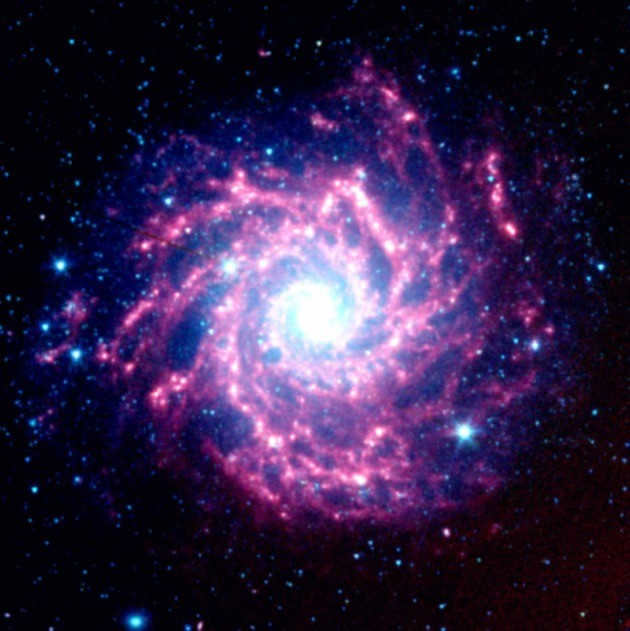
Redshift
It was Vesto Slifer who first observed that the spectrograms of galaxies, particularly those located far from our own galaxy, display a significant amount of red color. This phenomenon, known as redshift, refers to the shift towards the red end of the spectrum.
Redshift serves as evidence that galaxies are in motion, both rotating and moving away. Consequently, this suggests that the universe is undergoing expansion.
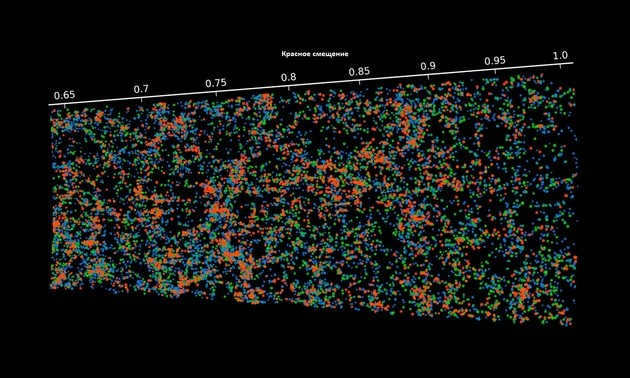
Hubble’s Law (also known as the law of redshift)

Back in 1929, Edwin Hubble made an astounding observation linking the velocity of distant galaxies moving away from our own galaxy to their respective distances.
He devised a formula that enables one to compute the speed of a galaxy as well as its distance from Earth. This groundbreaking discovery came to be known as Hubble’s law (also known as the law of redshift).
While this law exclusively applies to faraway galaxies, it provided concrete evidence for the expansion of the Universe. By utilizing Hubble’s law, it became possible to determine the moment the Universe began expanding, which in turn allowed scientists to estimate the age of the universe – 13.8 billion years.
Scientists came to the conclusion that before the formation of the universe, there existed a singularity.
This is the state that existed prior to the occurrence of the Big Bang and the formation of the universe.
As per the general theory of relativity, a black hole contains a singularity at its core. It represents an area where time ceases to exist and the principles of physics are no longer applicable. It is an area where all matter is compressed to an extremely small size under immense pressure.
In cosmology, there are three distinct concepts: cosmological singularity, gravitational singularity, and naked singularity.
The concept of a cosmological singularity
The cosmological singularity refers to the state of the universe both prior to the occurrence of the Big Bang and during the actual event itself. At this time, the universe was compressed into an extremely small size due to high pressure and exhibited a very high density.
Understanding gravitational singularities
A gravitational singularity is a specific point or region within the space-time continuum where it is impossible to draw a geodesic line or curve. This means that the laws of relativity theory do not hold true in these regions.
In the field of physics, specifically within the framework of general relativity, objects with minimal charge and mass follow the geodesic lines within the space-time continuum.
However, in the presence of a gravitational singularity, the laws of physics cease to be applicable, rendering it impossible to draw any lines or curves within these regions.
There exists a particular region within the fabric of space-time where the conventional laws of physics, specifically the principle of causality, cease to apply.
This principle is responsible for explaining how events or actions can influence one another. Essentially, it states that future actions cannot alter past events.
In simpler terms, our future does not have any impact or influence on our past.
According to the theories put forth by physicists, being inside a naked singularity would grant the ability to observe both past and future events. However, accessing such a singularity requires entering a black hole, which makes conducting experiments to study this phenomenon extremely challenging due to the impossibility of escaping a black hole.
Einstein’s groundbreaking theory: relativity
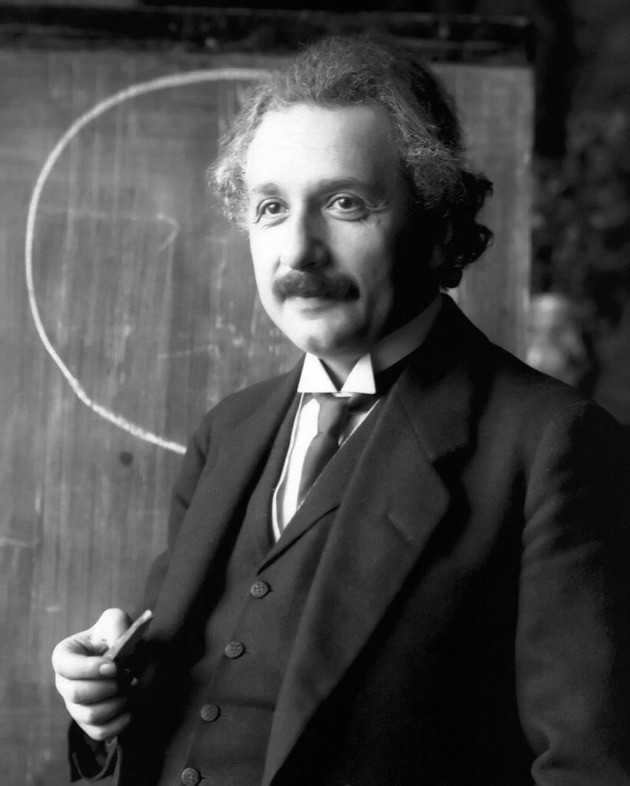
Albert Einstein came up with the special theory of relativity in 1905 and the general theory of relativity in 1915-1916.
Special theory of relativity
When two objects are in motion along a straight path with a constant speed, neither of them can be considered as a fixed point of reference. It is crucial to determine their movement only in relation to each other.
The concept of general relativity
Einstein made an attempt to elucidate the source of gravity. In line with his hypothesis, massive objects cause a distortion in the fabric of space and time. Consequently, this distortion gives rise to the phenomenon of gravity.
The equation formulated by Alexander Friedman
Alexander Friedman deduced an equation which provides evidence for the dynamic nature of the universe. From a mathematical standpoint, the scientist demonstrated that the universe is expanding and that it unquestionably originated from a specific point.
Subsequently, Hubble’s law provided further validation for his postulates.
In 1960, the field of cosmology was primarily considered a branch of philosophy. However, over time it has emerged as a prominent subfield within astrophysics and astronomy.
The philosophy of cosmology aims to explore ways of understanding the universe. It acknowledges that humanity currently has knowledge of only one universe and is unable to conduct traditional experiments or make comparisons with other universes. Additionally, the philosophy of cosmology seeks to uncover any potential implications and meanings associated with the universe.
Cosmology, as a discipline within astronomy, focuses on studying the origins and development of the entire universe. It perceives the universe as a system with unique characteristics.
Formation of Cosmology: A Historical Perspective
The concept of the origin and development of the universe has intrigued human minds since ancient times. In the beginning, the creation of the observable world was attributed to supernatural powers and deities. However, as the Renaissance and bourgeois revolutions swept across societies, the influence of religion on people’s perspectives diminished significantly. Over the past five centuries, scientists have diligently sought to elucidate the evolution of the universe through the lens of natural laws encompassing physics, chemistry, and more.


Originally, people believed that the world was a flat surface supported by three whales and a turtle
Originally, in ancient times, people had a limited understanding of astronomical objects. They were aware of the Earth, the Moon, the five planets of the Solar System, and the so-called “fixed” stars. Observations of the Sun, Moon, and planets moving across the Earth’s sky led to the mistaken belief that the Earth was the center of the Solar System and the entire Universe. This was known as the geocentric world system. However, with more careful observations, it was discovered that the Sun is actually the center of the Solar System, and only the Moon orbits around the Earth. This system is known as heliocentric. Regarding the stars, there were different theories initially, ranging from holes in the celestial sphere to distant suns. In the heliocentric system, the latter theory was explained by the absence of parallactic displacement caused by the Earth’s orbital motion around the Sun.
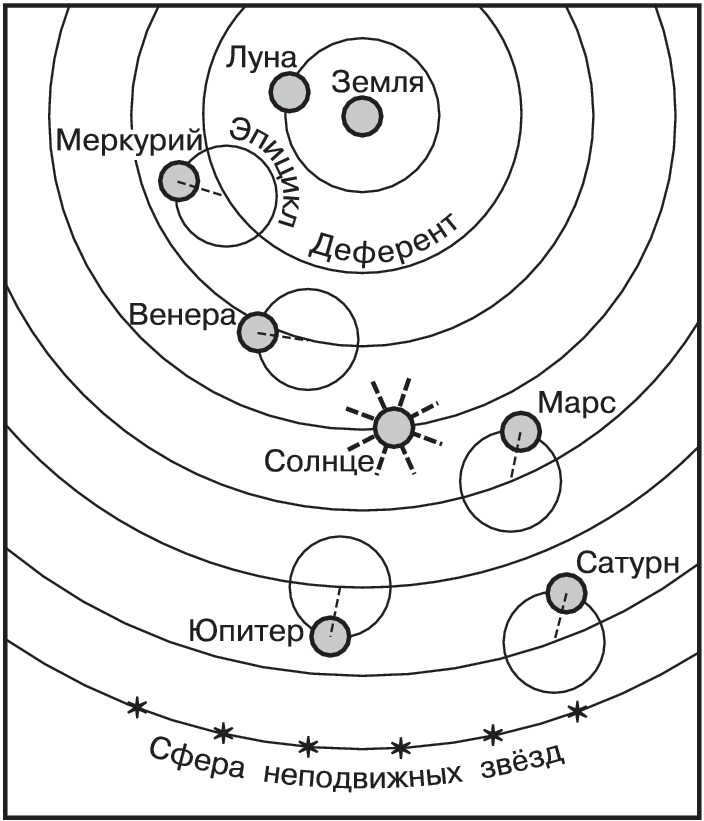
Advancements in Cosmology in the Past Few Decades
There have been significant advancements in the field of cosmology in recent years, with several key areas of focus:
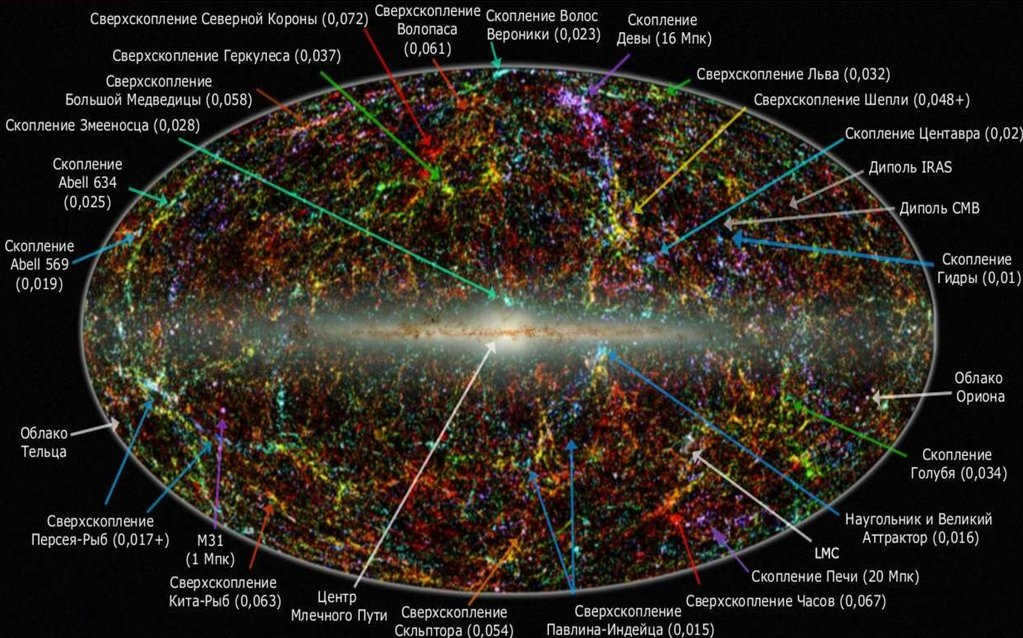
The overall structure of the Universe
– Infrared observations are being used to study the earliest stars and galaxies in the Universe, as the emission spectrum of these objects is shifted to the infrared range. Additionally, there is a growing interest in observing distant gravitational lenses using “natural” telescopes. These telescopes take advantage of the curvature of massive galaxy clusters’ gravitational fields to magnify the images of distant and faint objects, such as the first stars and galaxies. Through these observations, researchers have been able to observe very distant supernovae and even ordinary stars.
– The detection of residual (relict.) radiation in the submillimeter range of the electromagnetic spectrum is the process of registering the lingering signal left over from the moment when the primary matter of the Universe became transparent to electromagnetic radiation. The analysis of relic radiation provides valuable insights into the Universe, allowing us to explore its characteristics and evolution from approximately 370 thousand years after the event known as the Big Bang.
– In the foreseeable future, there are expectations of detecting other extraordinary forms of radiation, which will provide us with the opportunity to investigate an even earlier stage of the Universe. Specifically, we are referring to the relic radiation of neutrinos and gravitational waves. This is primarily because neutrinos and gravitational waves possess a much greater ability to penetrate matter compared to electromagnetic radiation. The former radiation originates from a Universe that is approximately one second old, while the latter radiation emerges from a Universe that is merely 10 to the -43rd degree of a second old.
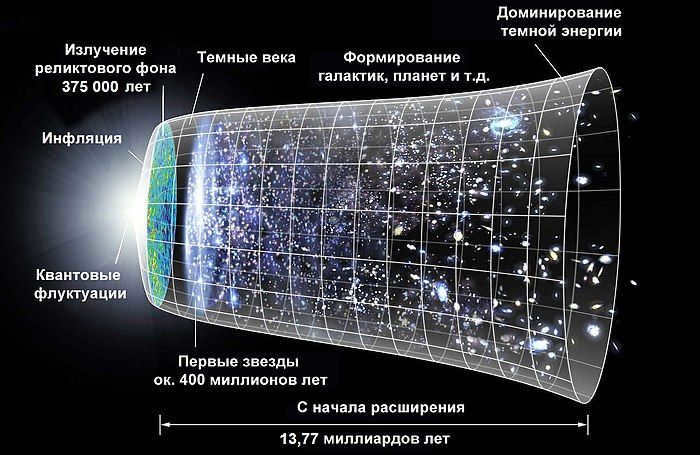
The development of the Universe following its inception
The process of mapping the Universe on the largest scales is currently gaining momentum. It is well known that the Universe is structured like foam, with cells that are several hundred million parsecs in size. These cells are vast voids where no large galaxies are observed. However, the boundaries of these cells contain enormous superclusters of galaxies. The mapping of the Universe is conducted through various methods, including spectroscopic surveys of millions of galaxies and other techniques such as measuring the redshift of optical afterglow from gamma-ray bursts or cataloging galaxies with active nuclei known as quasars. In recent years, another method that has gained popularity is the careful mapping of relic radiation. By studying the irregularities in the distribution of matter in the young and modern Universe, we can gain insights into the evolution of the Universe. A significant aspect of this mapping process is the search for “hidden” mass, also known as dark matter. The nature of dark matter still remains a mystery, and even the most meticulous searches conducted by particle detectors on Earth have not been able to identify any potential candidates for these unknown elementary particles that could make up dark matter.
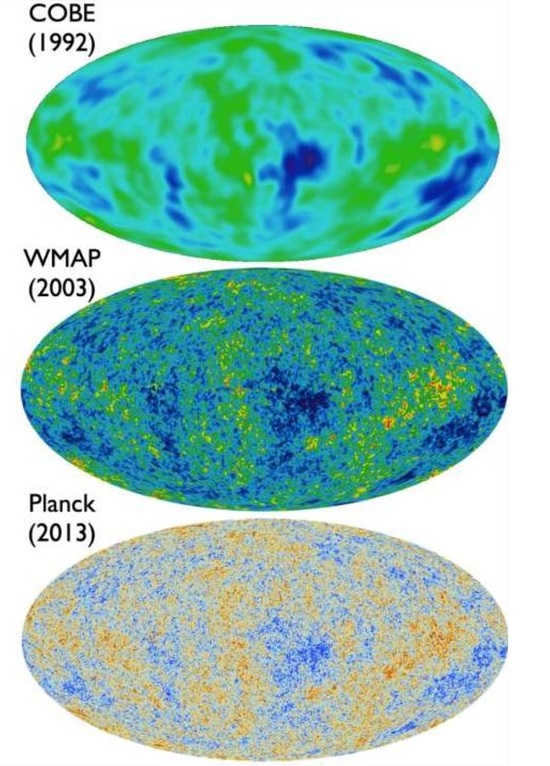
Inhomogeneities in the relic emission of electromagnetic waves according to various surveys
– The increasing computational power of supercomputers enables the enhancement of modeling capabilities for understanding the origin and development of the Universe. By comparing the observed and simulated evolution of the Universe, scientists can identify problematic areas in the theoretical foundations of cosmology.
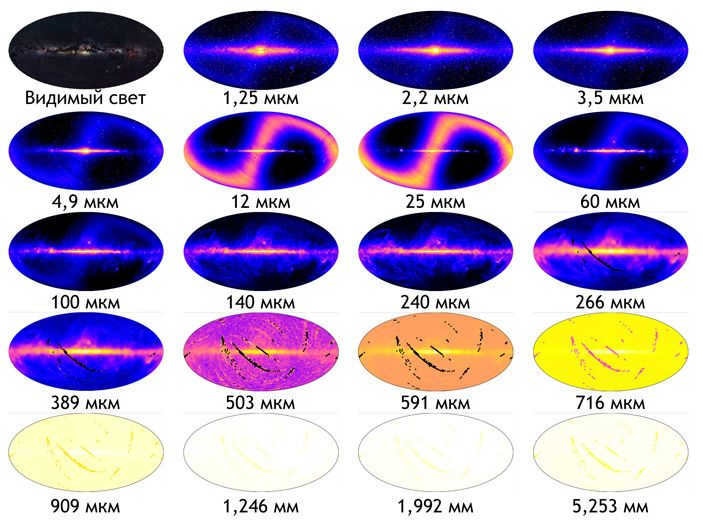
Maps of the sky in relation to the galactic plane can be observed using various wavelengths of the electromagnetic spectrum (EMS).
Within the range of EMS, specifically wavelengths of around half a millimeter, the most prominent features are the luminous spiral arms of our galaxy and the zodiacal light. The zodiacal light appears as a distinct line spanning the entire sky, and is best observed at a wavelength of 2.5 centimeters. Moving up to wavelengths of a few millimeters, one can clearly observe the background radiation that permeates the entire sky. This radiation is known as relic radiation.
The fundamental principles of cosmology
An essential principle of cosmology asserts that our universe is a continuously expanding realm with a diameter of numerous tens of billions of light years, comprising several trillion galaxies of various sizes. The rate of expansion of the universe can be described by Hubble’s law:
υ=Hr, where H represents Hubble’s constant, υ denotes the velocity of a galaxy, and r symbolizes the distance to the galaxy.
By interpolating the expansion of the Universe, it becomes apparent that approximately 13.7 billion years ago, the Universe existed as a singular point – a concentrated mass of primal matter and energy. The birth of the universe is elucidated by the concept of the Big Bang. According to theoretical calculations, prior to the emergence of the first stars in the universe, the chemical composition of the universe consisted of approximately three-quarters hydrogen and one-quarter helium.
The Big Bang is a concept in cosmology that outlines the initiation of the Universe’s evolution. Prior to this event, the Universe existed in a state of singularity. The remnants of the Big Bang are present in the form of relic radiation, which can be observed in the electromagnetic or gravitational-wave spectrum, as well as relic neutrino radiation.
What is the focus of cosmology?
Cosmology primarily investigates the initial stars and galaxies, as well as residual radiation (such as electromagnetic, gravitational wave, and neutrino radiation) and distant supernova eruptions.
Challenges within the Big Bang theory
The Big Bang theory poses several key questions:
– What triggered the expansion of the Universe?
– What constituted the Universe prior to its expansion?
Additionally, cosmology faces the challenge of predicting the future of the Universe. Various possibilities exist, ranging from infinite expansion (the “big bang” theory) to a transition from expansion to contraction, ultimately leading to a new Big Bang – the theory of cyclic Universe evolution.
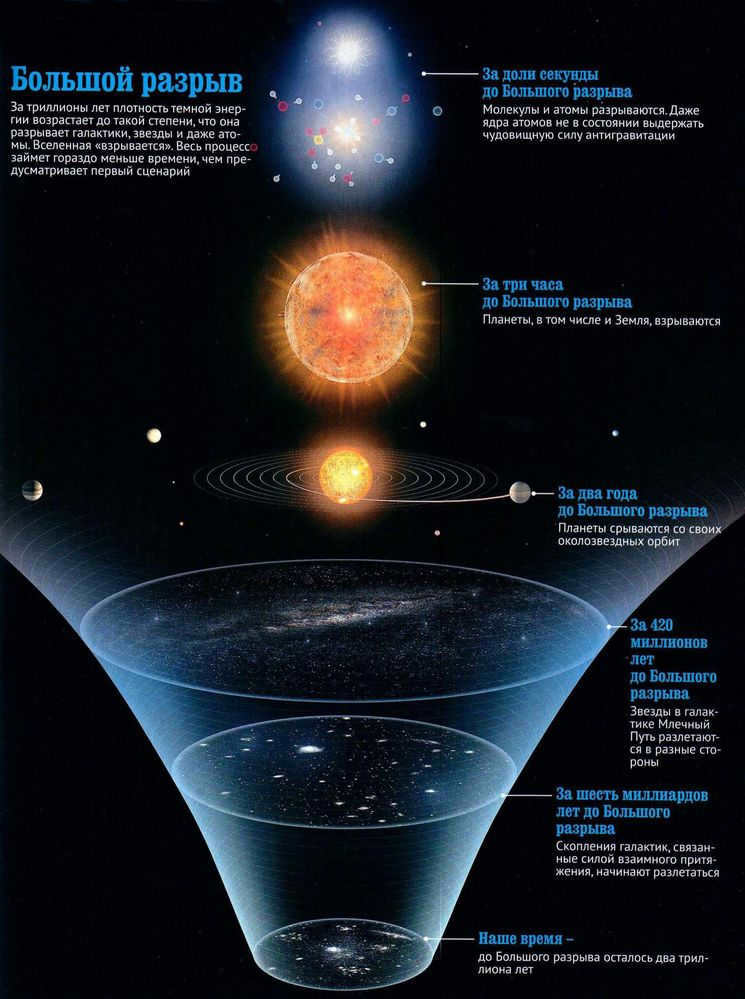

Schematic representation of the potential destiny of the Universe – the theory of the "Big Bang"
Currently, a new issue has arisen: a notable discrepancy exists between the estimations of the Hubble constant derived from two distinct methods (by analyzing relic survey data from the Planck spacecraft and measuring the distance to extragalactic Cepheids).
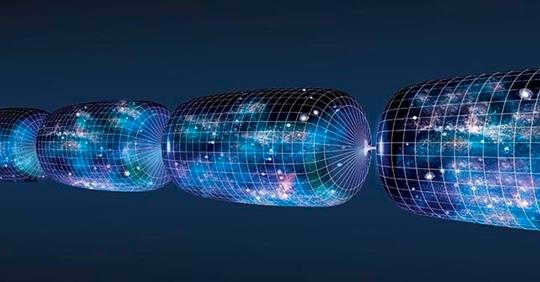
Schematic depiction of the potential cyclical progression of the Universe
Distinguishing features of astronomy and cosmology
In spite of examining the same universe, astronomers and cosmologists diverge in their respective areas of investigation. This disparity arises from the fact that astronomy centers primarily on analyzing specific celestial entities such as asteroids, planets, stars, and galaxies, whereas cosmology scrutinizes the universe as a unified whole.

Cosmology is the scientific discipline that investigates the characteristics and development of the universe as a unified entity. It is also a branch of astronomy that delves into the origins and subsequent progression of the cosmos.
The scientific concept of cosmology encompasses a comprehensive exploration of the universe, encompassing philosophical notions as well.
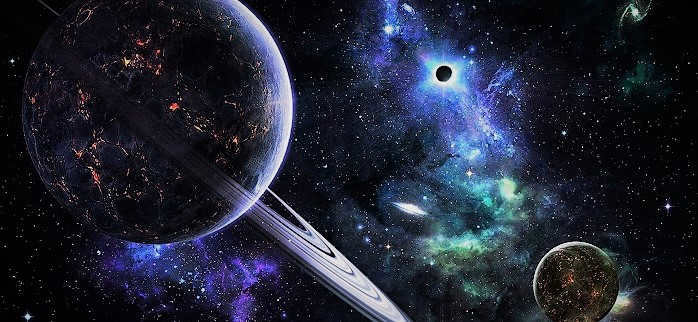
Cosmology is an interdisciplinary field that incorporates the principles of astronomy, physics, astrophysics, and mathematics to explore the nature and origins of the universe. It encompasses the study of the universe’s basic principles and advancements, including the application of both the theory of relativity and the Big Bang theory.
What sets cosmology apart from astronomy?
This inquiry is a common one, and for good reason. Cosmology and astronomy, while related, actually refer to distinct fields of study. Cosmology delves into the characteristics and evolution of the entire universe, while astronomy focuses on investigating the origins, structure, movement, and placement of celestial objects.

Furthermore, cosmology constitutes a significant component of the field of astronomy.
Additionally, cosmology allows for the presence of assumptions without concrete evidence, which is not permissible in the realm of astronomy. In other words, astronomy is a precise scientific discipline, whereas cosmology lacks the same level of rigor.
It is crucial to acknowledge that astronomy and cosmology are distinct fields of study, each pursued by different individuals. However, what unifies them is their pursuit of resolving the mysteries surrounding the origin and evolution of the universe.

Why does cosmology have connections with philosophy?
The emergence of science started with religious concepts. It can be argued that myths regarding the creation of the universe formed the basis for the development of cosmology. One well-known belief, for instance, is that God created the Earth and human beings, followed by everything else.
By contemplating such a theory, individuals were motivated to investigate their surroundings, which in turn led to numerous discoveries.

The Significance of Cosmology in Philosophy
Undoubtedly, cosmology plays a vital role in philosophy as it addresses fundamental inquiries regarding the human existence. In particular, it provides insights into our position within the vast universe.
The philosophical underpinnings of cosmology are rooted in humanity’s perception of the universe and the world that surrounds us.

It is worth noting that there are various branches of science that focus on different aspects of cosmology. One such branch is quantum cosmology, which explores the impact of quantum mechanics on the origin and evolution of the universe.
Another branch is transcendental cosmology, which deals with anomalous phenomena occurring in the cosmos. However, it also considers the universe as a unified system and its potential future, establishing fundamental principles for physics.
Therefore, cosmology can be defined as the scientific study of the origins and development of the universe. In this sense, cosmology can be seen as a science that looks towards the future. Despite significant discoveries already made, there are still numerous unanswered questions about the nature of the universe.

Throughout history, humans have been curious about their position in the world, the surrounding environment, and the name of it all. The celestial bodies such as stars and planets are integral parts of the vast universe that encompasses us. The knowledge of these entities, theories concerning the origins of the universe, physical hypotheses, mathematical principles, and philosophical concepts have all merged into a single science known as cosmology. But what exactly is modern cosmology, and upon what foundations does it rest?
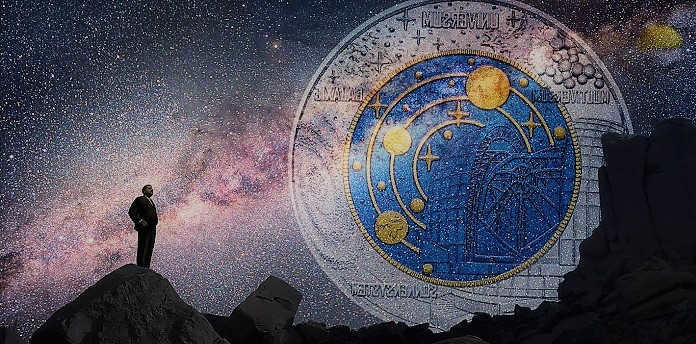
What led to advancements in modern cosmology
When discussing the era during which the aforementioned field of study experienced significant progress, it is important to note the 20th century. It was during this time that Albert Einstein proposed multiple theories regarding the nature of the universe. Later, he substantiated these theories by demonstrating the gravitational field equation. These investigations were closely tied to the general theory of relativity, which gained considerable attention during that period.
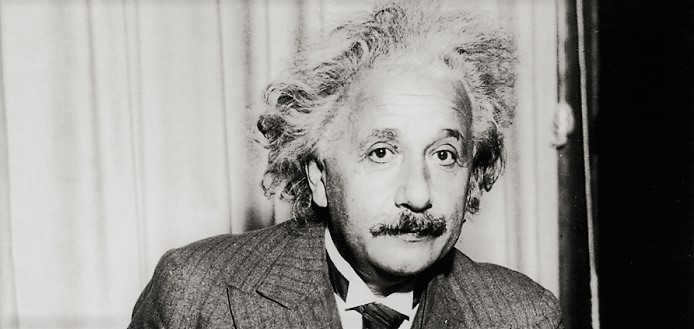
In his initial publication titled “Cosmological considerations to the general theory of relativity,” Einstein formulated three postulates. These postulates assumed the homogeneity, stationarity, and isotropy of the universe.
To substantiate his claims, Einstein employed the gravitational field equations and introduced an additional variable. Through this approach, he was able to find a solution that served as evidence for his postulates.
It was discovered that the universe possesses certain boundaries and exhibits positive curvature.
However, the research did not stop there. Alexander Alexandrovich Friedman (1922) further developed Einstein’s equations and proposed an alternative, nonstationary solution. According to Friedman, the Universe was expanding from an initial singularity.

By the way, Friedman’s assumption was proven true when Edwin Hubble made the discovery of cosmological redshift. These groundbreaking findings led to the development of the Big Bang theory, which remains relevant to this day. In essence, it is the discoveries made in the 20th century that form the basis of modern cosmology, despite the fact that the study of this science began much earlier.
In fact, modern cosmology has determined the age of the universe to be 13.8 billion years.
The currently accepted classification of time periods
Presently, the earliest era is recognized as the Planckian epoch. This is because the earliest theoretical concepts emerged precisely during this time period. Based on available data, it was during this epoch that the gravitational interaction became independent and separate from the other fundamental forces.
The subsequent era is known in scientific circles as the emergence of the first quark particles and the separation of interaction forces. Since this epoch relates to a later time interval, scientists have been able to obtain a fairly detailed description of all the processes that took place during this period.
The final interval is characterized by the formation of celestial bodies (such as stars), galaxies, and the entire solar system. Furthermore, this period is still considered to be ongoing and incomplete.
It is important to mention that the era of recombination holds significant importance in the development of the Universe. This period marked the point when the Universe became transparent to radiation, allowing it to be observed, such as in the form of a relic background. This experiment served as a solid confirmation of the validity of various models of the universe.
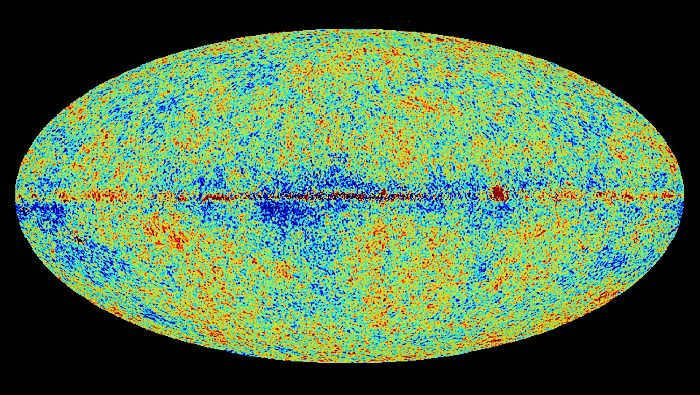
The Evolution of Cosmology in Modern Science
Before delving into the advancements made in modern cosmology, it is important to acknowledge the earlier stages of research.
Foremost among these is the pioneering work of Nicolaus Copernicus during the 15th century. Copernicus synthesized the accumulated knowledge from previous eras, including the contributions of Samosky, Leonardo da Vinci, Heraclitus, and Cuso. His central idea was that the solar system is inertial, with the sun positioned at its center and the planets, including Earth, orbiting around it.
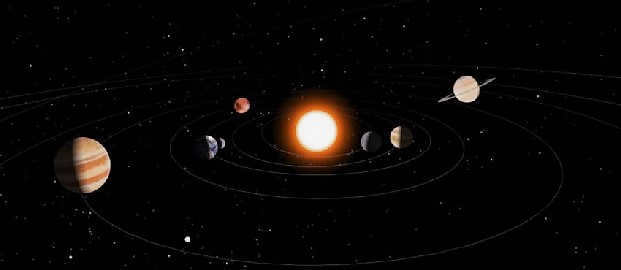
Kepler made his contribution a bit later. He eventually formulated three significant theories. These theories were later employed by Newton in his laws of dynamics.
Furthermore, the most noteworthy discoveries took place in the 20th century. As mentioned earlier, Einstein, Friedman, and Hubble were the initial scientists to disseminate their discoveries. Following that, Fritz Zwicky proposed the concept of a specific substance’s existence – dark matter. This substance is unresponsive to electromagnetic radiation but does play a role in gravitational forces.
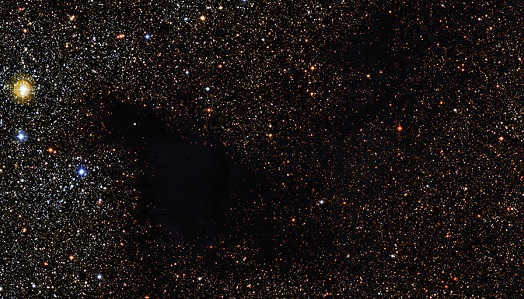
Gamow (who proposed the theory of the hot Universe), Penzias and Wilson (who identified the isotropic source of interference in the radio range) were notable figures in this context.
To sum up, it can be said that there is a strong interconnectedness between physical laws and cosmology. Numerous results and evidence for theories have been successfully justified from a physical perspective.
There are multiple theories about the origin of the universe. One of these theories is theological in nature, specifically the one described in the Bible. According to biblical teachings, for a certain period of time, the universe remained concealed and invisible to others, beyond the reach of human perception.
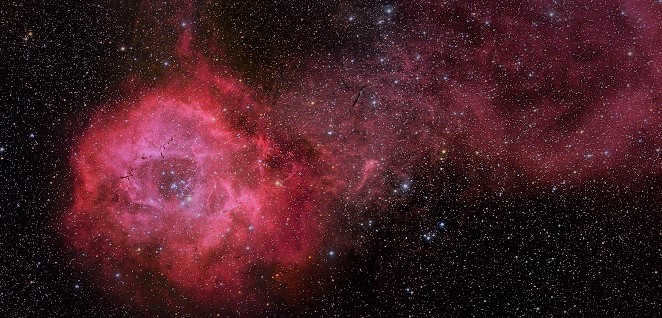
However, additional hypotheses emerged based on scientific analysis. Einstein initially proposed that the universe was stationary, but this idea was later disproven by Friedman, who demonstrated its contraction and expansion due to specific movements. Subsequently, Hubble’s research revealed precise distances to other galaxies, leading to the development of the Big Bang theory.
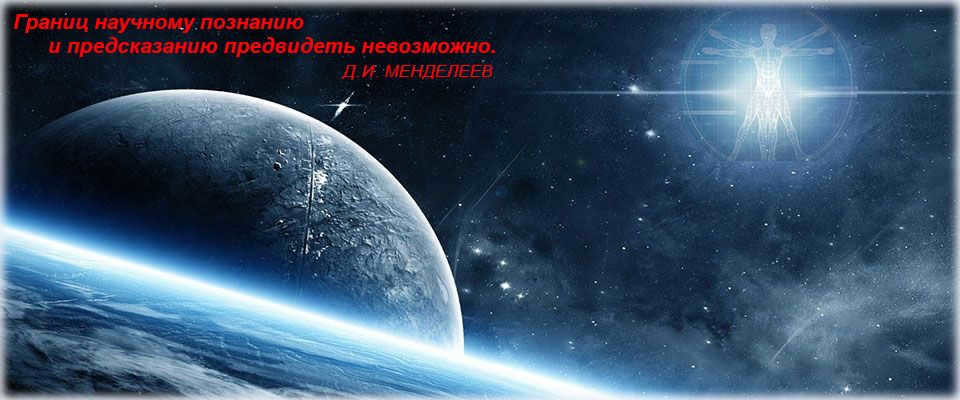

From the dawn of time, humans have been driven to comprehend the structure of the world surrounding them, contemplating the nature of stars, planets, and even the sun itself, as well as pondering their origins. Countless generations have dedicated themselves to unraveling these mysteries, ultimately giving rise to the field of cosmology.
Cosmology, a branch of natural science, focuses on the study of the universe as a whole, including its properties and evolution.
The term “cosmology” itself originates from two Greek words: “kosmos” meaning the Universe and “logos” meaning law or doctrine.
Cosmology combines the advancements and methodologies of astronomy, physics, mathematics, and philosophy. Its foundation lies in astronomical observations of the Galaxy and other stellar systems, as well as the general theory of relativity, the physics of microprocesses and high energy densities, relativistic thermodynamics, and various other contemporary physical theories.
The development of Einstein’s general theory of relativity (GTR) and elementary particle physics in the 20th century is closely linked to the emergence of modern cosmology. In 1917, Einstein published the first study on this subject titled “Cosmological Considerations to the General Theory of Relativity”, which was based on GTR. In this publication, Einstein introduced three assumptions: the universe is homogeneous, isotropic, and stationary. To fulfill the requirement of stationarity, Einstein introduced an additional “cosmological term” into the equations of the gravitational field. The solution he obtained indicated that the Universe has a finite volume (closed) and positive curvature.
In 1922, A. A. Friedman put forward an original idea for a dynamic answer to the Einstein equation, wherein the Universe, which was initially an isotropic entity, began expanding from a singularity. The verification of this nonstationary Universe theory came in 1929 when E. Hubble observed the cosmological redshift of galaxies. Consequently, the Big Bang (BB) theory, which is now widely acknowledged, was born.
Modern scientific theories suggest that approximately 13.8 billion years ago, the Universe we currently observe originated from a singular state and has been expanding and cooling ever since.
Based on the limitations of modern physical theories, the earliest moment that can be described is known as the Planckian epoch, which had a temperature of around 10^32 K (Planck temperature) and a density of approximately 10^93 g/cm³ (Planck density). The early Universe, as described by the BW model, was a highly uniform and isotropic medium with extremely high energy density, temperature, and pressure. As the Universe expanded and cooled, phase transitions similar to the condensation of gas into liquid occurred, but in relation to elementary particles.
The currently accepted periodization
- The earliest epoch that has any theoretical assumptions is known as the Planck time (10 -43 s after the Big Bang). During this period, the gravitational interaction became distinct from the other fundamental interactions. According to contemporary theories, this quantum cosmology epoch lasted until around 10 -11 s after the Big Bang.
- The following epoch is marked by the emergence of quark particles and the separation of different types of interactions. This epoch extended until approximately 10 -2 s after the Big Bang. Currently, there exist opportunities for a sufficiently detailed physical explanation of the processes that occurred during this period.
- An important event in the history of the Universe is believed to be the era of recombination, when the matter of the expanding Universe became transparent to radiation. This occurred approximately 380,000 years after the Big Bang. Presently, we are able to observe this radiation as relic background, which serves as a crucial experimental validation of the existing models of the Universe.
- Consequently, the XX century is widely recognized as the era when modern cosmology was born. It emerged at the start of the century and progressively assimilated the latest advancements, including the construction of large telescopes, space travel, and computer technology.
Timeline of Accomplishments in Modern Cosmology
The initial strides towards the development of modern cosmology were taken between 1908 and 1916. During this period, Henrietta Livitt (USA) discovered a direct correlation between the period and apparent magnitude of Cepheids in the Small Magellanic Cloud. This breakthrough allowed Einar Hertzsprung and Harlow Shapley to devise a method for determining distances using Cepheids.
In 1916, A. Einstein formulated the equations for the general theory of relativity, which laid the foundation for prevailing cosmological theories. In 1917, in his quest to create a solution that described a “stationary” universe, Einstein introduced an additional parameter known as the cosmological constant to the equations of the general theory of relativity.
In the years 1922-1924, A. Friedman utilized Einstein’s equations (both with and without the cosmological constant) to analyze the entire Universe and derived nonstationary solutions.
In 1929, Edwin Hubble made a groundbreaking discovery known as Hubble’s Law, which states that the rate at which galaxies are moving away from each other is directly proportional to their distance. This realization indicated that the Milky Way is just a small component of the vast Universe surrounding us. Additionally, this discovery provided evidence supporting Kant’s hypothesis that certain nebulae are actually galaxies similar to our own. Simultaneously, Friedman’s findings regarding the nonstationarity of the Universe were validated, further confirming the validity of the chosen path of cosmological development.
Starting from this moment and continuing until 1998, the dominant model is the classical Friedmann model without a cosmological constant. The impact of the cosmological constant on the final solution is studied, but since there is no experimental evidence indicating its significance for describing the Universe, these solutions are not applied for interpreting observational data.
In 1932, F. Zwicky introduces the concept of dark matter – a substance that does not emit electromagnetic radiation but does interact gravitationally. At that time, the idea was met with skepticism, but around 1975 it experiences a resurgence and becomes widely accepted.
In 1964, A. Penzias and R. Wilson made a groundbreaking discovery in the radio band – they stumbled upon an isotropic source of interference. It was later revealed that this interference was actually the long-predicted relic radiation theorized by Gamow. This discovery not only confirmed the theory of a hot Universe, but also brought together the fields of elementary particle physics and cosmology.
Between 1991 and 1993, the Relikt-1 and COBE space experiments furthered our understanding of relic radiation by uncovering fluctuations within it.
In 1998, researchers studying distant supernovae, specifically Ia supernovae, observed something extraordinary – the Hubble diagram for large z indicated that the Universe is expanding at an accelerated rate. This contradicted the predictions of the Friedmann model, which only accounted for gravity. To explain this phenomenon, scientists introduced the concept of antigravity in the form of a cosmological constant. This led to the idea of a mysterious form of energy called dark energy, which is believed to be responsible for the acceleration. The emergence of the ΛCDM-model, a modern theory of expansion, took into account both dark energy and dark matter.





